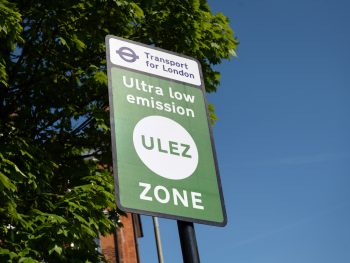By Rishi Mehra, vice president of commercial routing and mapping technology, Trimble

The drive towards urban areas with cleaner air continues across the UK as the current deadline of ending the sale of new petrol and diesel cars and vans in 2035 draws nearer. With the August 2023 expansion of London’s Ultra Low Emissions Zone (ULEZ) and as more cities across England and Scotland introduce Clean Air Zones (CAZ) and Low Emission Zones (LEZ), it’s clear these initiatives to achieve cleaner, safer air through net zero vehicles are on the rise.
While the environmental benefits are evident, these initiatives to reduce pollution and alleviate the healthcare strains on the population have had unexpected effects on many businesses, including increased operational costs and forced fleet upgrades – ultimately affecting short-term profit margins and necessitating upgrades to route planning equipment.
Courier, express and parcel businesses have felt the brunt of these effects due to larger fleets and older petrol and diesel vehicles — which on average have been on the road for more than 10 to 20 years. Since it’s impossible for businesses to swap out all vehicles in a fleet at once to meet the new lower emission standards, businesses are forced to slowly phase out older petrol and diesel vehicles and will be liable for daily £12.50 low-emission charges. Despite many business owners having applied for low-emission compliant vehicles, the recent global microchip shortage has caused delays in some businesses receiving compliant vehicles in time for London’s ULEZ expansion.
Additionally, the continuous M25 closures around London are expected to compound this issue by continuing to cause further traffic disruptions throughout the summer. National Highways has informed motorists that they will not be charged for entering the Clean Air Zone – as long as they stay on designated routes even if their vehicles are not compliant with the ULEZ or LEZ – but vehicles that deviate from these routes do run the risk of being caught and facing enforcement action.
Anticipation and preparation
As a result of the recent ULEZ expansion and the ongoing delays on the M25, some professional drivers may find themselves penalised for not being prepared – especially if they rely on consumer sat nav solutions. Alternatively, if drivers stray from the designated route in favour of a shorter one, they’ll be hit with additional fines.
As Clean Air Zones spread globally and around the UK in cities such as Birmingham, Bath, Oxford and Portsmouth, more and more businesses and commercial drivers throughout the UK will be affected by the new fines.
As technology has advanced, it has become commonplace for drivers to rely on online maps and navigation tools – which are often geared towards non-professional drivers and don’t take into account truck-safe routes and requirements. However, effective route optimisation for commercial drivers requires far more insight than simple, ubiquitous directions that can’t differentiate between a commercial vehicle and a two-seat sports car.
Commercial mapping intelligence has evolved beyond simple visualisations to offer a wide range of insights about business and driver behaviour to enhance fleet management. Complex routing algorithms are used to determine the most efficient routes for delivery or service vehicles by considering factors such as traffic patterns, road permissions, congestion and Clean Air Zones, low bridges, narrow lanes and fuel consumption.
Layering these demands over a business’s goals of sustainability, controlling costs, and meeting tight delivery deadlines has highlighted the limitations of generic mapping and routing solutions. Businesses cannot afford to risk using generic consumer navigation solutions and doing so has been a painful and costly lesson for many transportation companies. For example, taking a hazardous load through a tunnel without permission, diverting into Low Emission Zones, tiny rural lanes not suitable for large HGVs, and the damage and cost incurred when crossing under a low bridge are major risks when using ill-equipped consumer routing and navigation tools.
Boosting fleet efficiency

Smart mapping solutions not only take into account vehicle specifications, delivery requirements, detour distances and traffic conditions, these tools also enable businesses to navigate the Low Emission Zones throughout the UK and ongoing and future road closures such as the M25. Smart mapping technology offers drivers precise routes at the start of their journey, helping minimise unnecessary detours and reducing both time spent on the road and fuel consumption. This precision allows transportation businesses to plan more effectively, optimise routes, save money on fuel, and minimise the impact of incurring zone charges.
Intelligent mapping guarantees that each route is optimised according to the type of vehicle specified, ensuring driver safety, efficiency and – most importantly – legal compliance within Low Emission Zones. For drivers who work around London and other low-emission compliant cities, this is a must-have tool in light of the disruptions.
Ensuring compliance with evolving regulations
With London’s ULEZ expansion reshaping how transportation businesses and drivers negotiate their travel around the capital – and as more cities across the UK introduce Low Emission Zones – businesses must be proactive and harness the power of advanced mapping technologies to mitigate the impact of increased charges and route complexities.
Innovation can empower businesses to adapt, minimise costs and ensure compliance with evolving regulations – even in the face of global supply chain disruptions and temporary road closures. Staying informed and leveraging technology will allow commercial drivers to navigate closures and the expansion of Low Emission Zones more effectively, protecting their bottom line and the UK’s environmental efforts.

